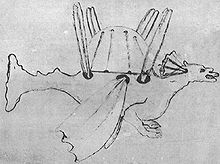Tito Livio Burattini


Tito Livio Burattini (
nobleman, who spent his working life in Poland and Lithuania.[1][2][3] He was born in Agordo, Italy, and studied in Padua and Venice. In 1639, he explored the Great Pyramid of Giza with English mathematician John Greaves;[3][4] both Burattini and Sir Isaac Newton used measurements made by Greaves in an attempt to accurately determine the circumference of the earth.[citation needed
]
For
glider wings in 1647.[2] Described as "four pairs of wings attached to an elaborate 'dragon'", it was said to have successfully lifted a cat in 1648 but not Burattini himself.[5] According to Clive Hart's The Prehistory of Flight, he promised that "only the most minor injuries" would result from landing the craft.[6]
He later developed an early
system of measurement based on time, similar to today's International System of Units; he published it in his book Misura universale (lit. "universal measure") in 1675 at Vilnius.[4] His system includes the metro cattolico (lit. "catholic [i.e. universal] metre"), a unit of length equivalent to the length of a free seconds pendulum; it differs from the modern metre by half a centimetre.[7][8] He is considered the first to recommend the name metre for a unit of length.[8][9][10][11][12][13][14]
Along with two others he met at
He died in Kraków, aged 64.See also
References
- ^ Frysinger, James R. "SI Background". SI Guide. Archived from the original on 2006-10-10. Retrieved 2009-05-24.
- ^ ISBN 978-0-521-05803-2.
- ^ ISBN 978-90-04-14761-4.
- ^ ISSN 0035-9149.
- ISBN 978-1-885119-68-1.
- ^ Qtd. in O'Conner, Patricia T. (1985-11-17). "In Short: Nonfiction; Man Was Meant to Fly, But Not at First". The New York Times. Retrieved 2009-05-24.
- arXiv:physics/0412078.
- ^ a b Lucendo, Jorge (23 April 2020). Centuries of Inventions: Encyclopedia and History of Inventions. Jorge Lucendo. p. 246. Retrieved 2 August 2021.
- ^ "Tito Livio Burattini - Biography, History and Inventions". History Computer. 4 January 2021. Retrieved 2 August 2021.
- ISBN 978-1-74382-138-1.
- ^ "Appendix B: Tito Livio Burattini's catholic meter". roma1.infn.it. Retrieved 3 August 2021.
- ^ "Science. 1791, l'adoption révolutionnaire du mètre". humanite.fr (in French). 25 March 2021. Retrieved 3 August 2021.
- ^ "The meter, an ingenious intuition from belluno | Italiani Come Noi". italianicomenoi.it. Retrieved 3 August 2021.
- ^ Holtebekk, Trygve (30 November 2020). "Meter". Store norske leksikon (in Norwegian Bokmål). Retrieved 3 August 2021.
- ^ Institute and Museum of the History of Science- Multimedia Catalogue - Biographies. Retrieved 2009-05-24.
- ^ "Tito Livio Burattini [attr.], Calculating machine". Institute and Museum of the History of Science - The Medici and Science. Retrieved 2009-05-24.
External links
Wikimedia Commons has media related to Tito Livio Burattini.
- Misura universale (1675, at Gallica)
- Nuncius: Annali di Storia della Scienza, issue 1998, especially section titled "G. MONACO, Alcune considerazioni sul «Maximus tubus» di Hevelius."
